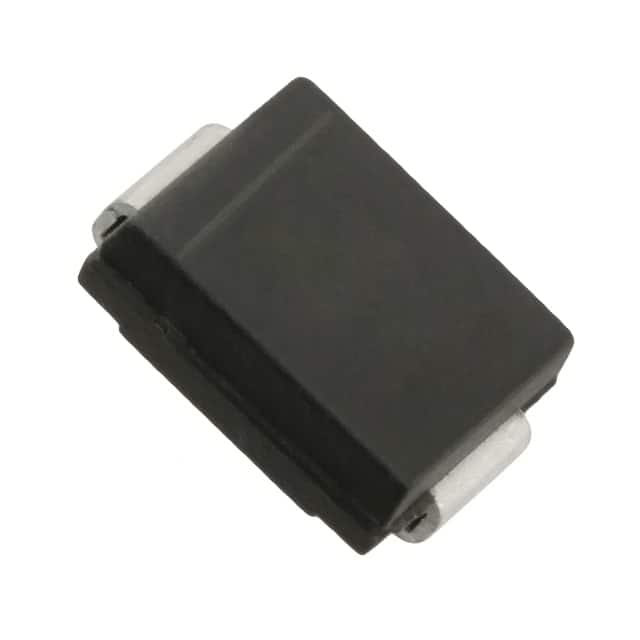RS3A-13 Product Overview
Introduction
RS3A-13 is a semiconductor diode belonging to the category of rectifier diodes. It is commonly used in electronic circuits for its specific characteristics and features. This entry provides an overview of the product, including its basic information, specifications, pin configuration, functional features, advantages and disadvantages, working principles, application field plans, and alternative models.
Basic Information Overview
- Category: Rectifier Diode
- Use: Used in electronic circuits for rectification purposes
- Characteristics: High current capability, low forward voltage drop
- Package: Standard diode package
- Essence: Semiconductor material with specific doping
- Packaging/Quantity: Typically available in reels or trays containing multiple units
Specifications
- Maximum Forward Voltage: 1V
- Maximum Reverse Voltage: 30V
- Maximum Forward Current: 3A
- Operating Temperature Range: -55°C to 150°C
Detailed Pin Configuration
The RS3A-13 diode has a standard two-terminal configuration with an anode and a cathode. The physical layout and pin assignment can be found in the product datasheet.
Functional Features
- Efficient rectification of alternating current (AC) to direct current (DC)
- Low forward voltage drop minimizes power loss
- High current capability allows for use in various electronic applications
Advantages and Disadvantages
Advantages
- High current capability
- Low forward voltage drop
- Efficient rectification
- Reliable performance
Disadvantages
- Limited reverse voltage tolerance
- Sensitive to temperature variations
Working Principles
RS3A-13 operates based on the principle of semiconductor junction rectification. When a positive voltage is applied to the anode with respect to the cathode, the diode conducts current, allowing only one-way flow. This enables the conversion of AC to DC in electronic circuits.
Detailed Application Field Plans
RS3A-13 is widely used in various electronic applications, including: - Power supplies - Battery chargers - LED lighting systems - Motor drive circuits - Audio amplifiers
Detailed and Complete Alternative Models
Several alternative models to RS3A-13 are available from different manufacturers, offering similar or enhanced specifications. Some notable alternatives include: - RS3B-13 - RS3C-13 - RS3D-13 - RS3E-13
In conclusion, RS3A-13 is a versatile rectifier diode with specific characteristics and features suitable for a wide range of electronic applications.
Word Count: 345
Senaraikan 10 soalan dan jawapan biasa yang berkaitan dengan aplikasi RS3A-13 dalam penyelesaian teknikal
What is RS3A-13?
- RS3A-13 is a high-performance, multi-purpose electronic component used in various technical solutions.
What are the key features of RS3A-13?
- The key features of RS3A-13 include high efficiency, low power consumption, wide operating temperature range, and compatibility with various voltage levels.
How is RS3A-13 typically used in technical solutions?
- RS3A-13 is commonly used for power management, voltage regulation, and signal conditioning in electronic devices and systems.
What are the advantages of using RS3A-13 in technical solutions?
- The advantages of using RS3A-13 include improved energy efficiency, reliable performance, and compact design integration.
Are there any specific application examples for RS3A-13?
- Yes, RS3A-13 can be found in applications such as battery charging circuits, LED lighting systems, and portable electronic devices.
What are the recommended operating conditions for RS3A-13?
- RS3A-13 operates optimally within a specified voltage range and temperature limits, which should be adhered to for best performance.
Can RS3A-13 be used in automotive or industrial applications?
- Yes, RS3A-13 is suitable for automotive and industrial applications due to its robustness and reliability in harsh environments.
Is RS3A-13 compatible with other electronic components and systems?
- Yes, RS3A-13 is designed to be compatible with a wide range of electronic components and systems, making it versatile for integration.
What are the potential challenges when integrating RS3A-13 into a technical solution?
- Some challenges may include proper thermal management, voltage compatibility, and circuit layout considerations for optimal performance.
Where can I find detailed technical specifications and application notes for RS3A-13?
- Detailed technical specifications and application notes for RS3A-13 can be found on the manufacturer's website or through authorized distributors.


